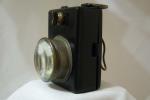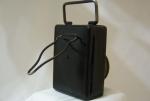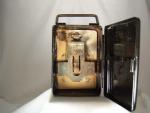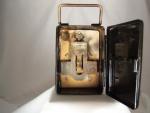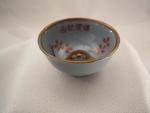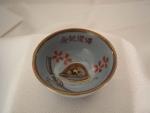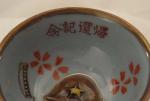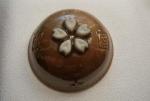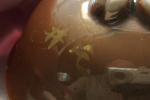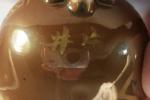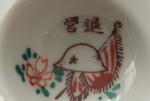-
Posts
6,486 -
Joined
-
Last visited
-
Days Won
10
Content Type
Profiles
Forums
Blogs
Gallery
Events
Store
Everything posted by Brian Wolfe
-
It is hard to tell from the photos but here's my thoughts. I like the nakago (tang) in that it shows rust, which is what you want. What I don't like is that this looks like it could have been cleaned at some time as the rust is not an even coating. I would also have liked to have seen file marks on the tang as these were always left and can tell a lot about the maker. Maker's names, while not always present, would have been a good thing to have seen on the nakago. The handle looks correct to the WWII Army standards except that the scabbard sleeve above the tsuba (guard) called the habaki has a decorative design which would not usually be found on a military issue as these are left plain. While the handle "looks" period correct to the WWII period I feel it is a little too clean to have been made/used/carried some 70+ years ago. The photos don't show the hamon (temper line) well enough however, it would appear to be straight and not wavy. This is not necessarily a sign that the blade was machine made as I have a nice example of a wahisazhi with a straight hamon that was hand made in the early 1930s. If the hamon is not there and the line of the hamon that I am seeing in the photo is actually caused by the shape of the blade then it was not hand made. The saya (scabbard) is too long for the blade. This would not be a bad thing if the saya was a shin-gunto (army pattern) as the saya was always regulation length even if a shorter "ancestoral, or family" wawakizashi was being carried. This scabbard is a storage scabbard and not meant for use in the field and would, I suspect, be the correct length for the blade. Over all this sword just looks to good to be authentic. None of the finish on any part of the wakizashi is worn or damaged, as I would expect to see in a sword that has been around for three quarters of a century. In my view I would thik this could very well be a modern Chineese copy, a very good one but a copy all the same. Please bear in mind that this is just my opinion based on photos that are not as clear as I would like and the final decision, as always, is yours to make. Even if this is an authentic sword I don't offer valuations, but if I saw this on a dealer's table my impulse would be to value it as a "Leaverite" (leave her right there) and walk away. I will be interested to read other opinions and please let us know what you find out and your final decision. Regards Brian
-
The next lamp featured to this post is a bit of a mystery to me. The top has a trade mark “HW” and no other indication of its origin. The dimensions are 3 ¾ inches tall, 1½ thick (body only) and 2 5/8 inches wide. The lens is of the fisheye style common with earlier lamps. I have included this light in the police category as it has the carrying handle and a device on the back that could hook over a belt or perhaps even allow the light to be suspended from a button on a tunic. The light is turned on and off by a switch on the front over the lens. Looking at the inside of the lamp it would appear that the battery was a rectangular shape with one pole connected in the middle front and the other pole connected to complete the circuit in the upper left hand corner (see photo to the left below). In this photo you can see the switch at the top in the “off” position. In the right hand photo you can see the switch in the “on” position. At times it is difficult to date lamps to specific time periods due to lack of information stamped on the lamp. However in this case I found this exact lamp advertised in a German catalogue dated 1919. By this I would assume these first came available near the end of the First World War. This being included in a German catalogue may indicate that it is German rather than British, however I cannot say either way with any confidence. When this lamp came into my possession it was in deplorable condition and required significant restoration. I usually leave items that become part of the collection much like they were found but in this case restoration was a necessity. Regards Brian
-
Amazing work and very well displayed. Thanks for sharing them with us. Regards, Brian
-
Hi Rich, Thanks for sharing this interesting specimen. A person could easily get involved in colecting sake cups with a passion, so many diferent and interesting designs. Regards Brian
-
GMIC’s Tenth Anniversary Eight years ago my friend in India, and fellow GMIC member, Samir, strongly suggested that I look into this forum with the intention of possibly joining. It hardly seems like eight years have passed by since I joined, but the numbers don’t lie; eight years and not one regret. True there have been times when I have found myself biting my lip for want of making a curt reply to someone’s remarks but calmer emotions took over and I refrained from adding fuel to the fire. This calming down process has taken several days in some cases but it is a matter of the ends justifying the means (in this case time). I’m not one to belong to very many forums, finding my “free” time limited; a phenomenon that has only increased since my retirement from public life last autumn. I have, on the other hand visited several other forums and researched material on some of my collectables found there. What I have found on some of these forums, not all being military orientated, was rather an eye opener. Compared with the GMIC some forums have an over abundance of rude, crude and lewd members, sort of “The Good, The Bad and the Ugly” of the internet. Some forums seem to have no set rules while others are quite draconian in there enforcement. That’s not to say there are no rules here, as there are and somewhat restrictive if one was to enforce them to the extreme. However that holds true with any law or legislation anywhere in the free world. What I have observed in the past and present is an overwhelming sense of gentlemanly conduct demonstrated by the membership. Only on rare occasions has it been necessary that the rule book be taken off the shelf, the thick layer of dust blown from the cover and the “Riot Act” read. The atmosphere generated, in my opinion, by our Chairman, Nick and the rest of the founding members have galvanized this group of collectors into what can only be described as a true internet “community”. It has been said that it takes a community to raise a child and this holds true here. It takes the whole community working together to foster this feeling of cohesiveness and desire to help one another to enjoy our hobby. In closing, I would like to wish the Gentleman’s Military Interest Club a happy 10th Anniversary and the hope for many more to come. Further to this I would like to thank our Chairman, Nick, for following through with his brain-child and developing what can only be seen as one of the top military interest forums on the internet today. Congratulations, Nick, on the 10th Anniversary of your successful creation. Regards Brian
-
Well done Rob. How was the rest of the show? Regards Brian
-
Thanks Rich, I'll do a search for one. I would think anything, such as the one you mentioned, that was post WWII would be more helpful than the one I have ordered. Regards Brian
-
Hi Jktu, I am not sure if I will be able to use the dictionary or not but I would like to be able to translate more on my own. I've started to save writen Japanese phrases and their English translations on my computer but this is a slow process. We have a world-class university very close by (University of Waterloo) and I have been thinking of seeing if I could hire a student to assist me with the translations on the cups and other items from Japan as well. The link you provided will not open up on my computer so I'll try it on my lap top later today, this sometimes works on sites that won't open on my computer. Thanks again. Regards Brian
-
Thank you very much fellows for you assistance. I've ordered a Japanese-English dictionary of military terms but it was written in 1902 so I'm not sure it will help with much after that date; but it is a another step toward educating myself. Regards Brian
-
That's the first time I've seen any letters associated in this manner along with the regimental number. To paraphrase Ed Haynes, "Anything can happen and In India at least twice". I hope others, like myself, will keep digging for the answer. Steak and beer at my place for whoever comes up with the answer first. Regards Brian
-
Help with Sake Cup Translation I have purchased another sake cup from a dealer who could not or would not provide a translation. I usually purchase from the same three or four dealers, all from Japan, but once in a while I do stray off the “path” and need assistance with the translations. This blue porcelain cup has a raised army helmet in the bottom along with cherry blossoms and a katana (military sword) painted around the helmet. Reading the Kanji (right to left) the last two kanji represents “Commemorative” but the first two have me completely puzzled. I hope someone can assist me with the translation. Regards Brian
-
Hi mickey, That is one of the most unique cups I've seen. Obviously, from the poem and army star it is military and I would think that would make it quite scarse. Of course if it was hand made then it could very well be one of a kind. I would like to start a thread just for sake cups and bottles and unless someone starts one first I'll get to it shortly. Thanks for sharing this wonderful sake cup with us. Regards Brian
-
Hi Rich, Well, that's a good one on me. In retrospect I suppose I sould have known that was the national flag. I'm not angry with the dealer as I did make the purchase for the cup's base. Still the dealer should indeed be more careful and I should stay with dealers I know and trust. Lesson learned. I have Dan King's book and the style of kanji is different in his examples for Discharge Commemorative; I have so much to learn. Many, many thanks for your assistance, Rich. Regards Brian
-
Japanese Photographic Division? I purchased a couple of sake cups from a local dealer a few weeks ago and the one he had claimed to be a Taiwan Occupation Commemorative, however, further research found that the kanji clearly stated it to be a China Incident Commemorative with no indication or suggestion that it had anything to do with Taiwan. No problems as I was happy with that purchase as I purchased it for the five artillery shell base (it is a helmet shaped cup). The cup I have questions about is a nice kabuto sakazuki (helmet shaped cup) with a five cherry blossom petals base. This, the dealer claimed was from the Japanese Photographic Regiment or Division. I have exhausted my limited resources as far as research and now turn to you for assistance. As I stated it is a five cherry blossom pedals base and the kanji on either side of the cherry blossom pedals stands for “patriotism” On the back of the helmet is a shape that appears to be a camera. It is hard to show it in the photos, but it certainly looks to be a camera to my eye. Above the “camera” are two kanji which I have tried to show in the photos. I took one photo of the cup upside down and turned it around with Photo Shop to try to show this as best as I could. I have taken photos of the two groups of two kanji on the inside as well. I do hope you can shed some light on this mystery and your assistance is, as always, appreciated. Regards Brian
-
Hi Mervyn, Sorry to have taken solng in my response. Each drawer has a brass lable holder. Yes, that would fall under the category of being obsessive. Regards Brian
-
Hi Larry, Once again you make a very good point. Those of us interested in collecting the medals of Independent India know every well the poor state of some stampings. We even see letters stamped the worng way around producing a backwards "E", for example. Regards Brian




